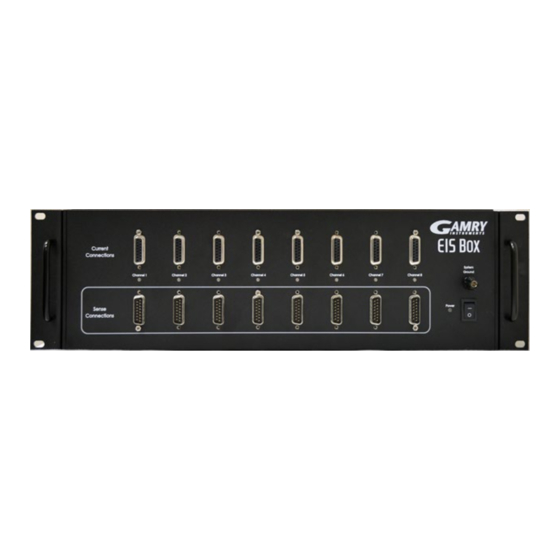Table of Contents
Advertisement
Quick Links
Introduction
About the EIS Box
The EIS Box (pronounced "ice box") is a value-oriented, research-grade
electrochemical instrument packaged in a small case. It is designed for
battery-testing via electrochemical impedance spectroscopy up to eight
cells.
The EIS Box excels at electrochemical impedance testing of small- to
medium-sized single-cell energy-storage and power-conversion devices.
Such devices include batteries, electrical double-layer capacitors, fuel
cells, and photovoltaic cells. The EIS Box can apply and measure currents
from 5 A to ~0.05 µA.
Features of the EIS Box include:
•
Six-decade current auto-ranging for large and small batteries,
•
Electrical isolation from earth ground, and
•
Both analog and digital filtering.
A sine-wave generator on the EIS Box allows the instrument to make
accurate impedance measurements at frequencies up to 100 kHz. EIS
performance is good for low-impedance systems (such as low-ESR
electrical double-layer capacitors).
A unique DSP (Digital Signal Processing) data-acquisition mode allows
the EIS Box to reject noise, from the instrument itself, from the
electrochemical cell, and from the lab environment. In many cases
where other instruments require a cell in a Faraday shield to make quiet
measurements, the EIS Box can be used with the cell exposed on a bench
top.
The EIS Box, like all our instruments, requires a computer for its use. The
EIS Box connects to this computer through an Ethernet or USB
connection (see photograph below of rear panel).
The EIS Box was developed to increase the throughput of your
impedance testing program. Under the control of an external computer,
the EIS Box connects one cell at a time, which makes an electrochemical
measurement on that cell.
The EIS Box has been integrated into all Gamry Instruments'
electrochemical impedance spectroscopy applications that run under the
Gamry Framework. It allows many of the EIS measurement applications
to increase their throughput by testing multiple cells in a single test run.
The Gamry Instruments Electrochemical Toolkit allows you to control the
EIS Box using a library of software routines. You can find examples of
such routines after you install the Electrochemical Toolkit software.
Introduction to the EIS Box
Typical applications for the EIS Box include:
•
Research in electrochemical storage and conversion, and
•
Battery and electrochemical capacitor evaluation.
General Operation
The EIS Box was developed to increase the throughput of your
electrochemical impedance testing program. It allows one instrument to
drive up to eight electrochemical cells. Under the control of an external
computer, the EIS Box connects one cell at a time to the instrument,
which makes an electrochemical measurement on that cell.
The EIS Box was specially designed for the needs of electrochemists.
Extra features such as sense line and shield-switching—designed
specifically for electrochemists—from other general-purpose switching
devices.
It allows many of the applications to increase their throughput by testing
multiple cells in a single test run.
Operation Overview
Figure 3-1 shows a "typical" electrochemical test system built around an
EIS Box instrument. Only four cells are shown in this figure, although up
to eight cells can be connected.
Figure 3-1 A Typical Electrochemical Test System Using the EIS Box
The system computer is a critical component of the system. It controls
the EIS Box by sending it simple commands through an ethernet or USB
connection.
The most important function of these commands is to select which cell is
active (connected to the EIS Box). You can think of an EIS Box as a
Advertisement
Table of Contents

Summary of Contents for Gamry Instruments EIS Box
- Page 1 The most important function of these commands is to select which cell is EIS Box using a library of software routines. You can find examples of active (connected to the EIS Box). You can think of an EIS Box as a such routines after you install the Electrochemical Toolkit software.
-
Page 2: Physical Location
Switching and Inactive Cell Control be found on www.gamry.com. In the Operation Overview, we said you can think of the EIS Box as a If you install from a physical medium, Gamry Software Setup program complex switch with controller. Each of the eight EIS Box channels is will normally start automatically when you place the Gamry Instruments’... -
Page 3: Reboot Your Computer After Software Installation
This is the same connector used on the US standard line cord supplied with your EIS Box. The EIS Box can be run via USB. To connect the EIS Box to a USB port on a computer: Be sure that the EIS Box is powered off and unplugged from the AC source (mains). -
Page 4: Running The Framework
Instruments Framework software and the instrument’s firmware. The standard Cell Cable is 3 m long. The D-connector ends of the cables are connected to the appropriate ports on the front of the EIS Box. Calibration Always use the knurled screws on this cable to hold the cables in place. -
Page 5: Ancillary Apparatus
Always screw both cell cables into place because cables can fall off the unit if not properly attached. This can be disastrous if detachment occurs The EIS Box can be used with membrane cells. In this type of cell, a during an experiment. -
Page 6: Rear Panel
Cell Connectors Rear Panel The EIS Box has two sets of eight cell cable connectors, for a total of 16 connectors on the front panel. Each connector is a 15-pin D-type connector. Each pair of D-type connectors is a channel, for connection to a cell or battery. - Page 7 The USB port on the rear panel of the EIS Box is a Type B receptacle for a USB cable. Use a standard USB cable with a Type B USB (nearly square) connector to connect this port to a computer’s USB port.







Need help?
Do you have a question about the EIS Box and is the answer not in the manual?
Questions and answers